Preston Plucknett Flax Works
Preston Plucknett Flax Works
An almost-forgotten industry once essential to the local economy
The cultivation of flax and hemp was once widespread and common to a considerable area in and around Yeovil, at least from the fourteenth century. In 1692 it was recorded that "great quantities of flax were sown in this year about Yeovil and a considerable quantity of good flax hath been sown last year for making cloth, ticking and sewing thread."
In 1795 it was recorded that ".... in the rich fertile country extending from Wincanton, through Yeovil to Crewkerne, flax and hemp are cultivated in great abundance." and in 1791 Collinson wrote about Yeovil "The market.... is very large for corn, cattle and pigs; for bacon, cheese, butter, flax and hemp" and in 1856, Daniel Vickery paraphrased "The market day is Friday, every alternate Friday being what is called 'The Great Market'. Corn, cattle, butter, cheese, hemp and flax, are also sold in great quantities."
The Preston Plucknett Flax Works was, during the latter part of the nineteenth century, where the flax grown in the surrounding district was sent. It was located in a field called Higher Sleight (Parcel 81) and was accessed by Eighteen Acre Lane, a field access track which is now a footpath running through the Abbey Manor housing estate.
Flax was such a big business locally that there was an Annual Flax Show held in conjunction with the Yeovil Agricultural Society in the Flax Room adjoining the Corn Exchange in Yeovil during the 1880s and 1890s.
During the First World War the demand for the increased production of flax led to the breaking up in 1917-18 of much land which was under pasture. Women and girls who were not employed on munitions found work at the flax factory, some of course regularly took over work previously carried out by men.
In 1920 it was noted that the annual crop capacity of the factory was 1,000 tons.
At the end of the war the Preston Plucknett Flax Works gradually decreased in profitability and the works finally closed and auctioned off in October 1931. The following description is taken from the sale details.
The factory and associated land was sold as being potentially suitable for development as a building estate and was extolled as "occupying a high, healthy situation with extensive and interesting views, and has a specially constructed artesian well capable of giving a considerable and constant supply of water."
The buildings "chiefly with cement floors" were listed as follows -
- An
excellent
brick-built
Store,
26ft by 32ft
in two
divisions
with WC and
with 4 rooms
above,
formerly
used as
Offices,
which could,
with but
little
alteration,
be converted
into a
pleasant
Dwelling
House.
- The
adjoining
substantial
wood-framed
and
galvanised-covered
Workshop,
61ft by
26ft.
- A
Dutch Barn,
25ft by
60ft, by
Dorman Long
& Co Ltd.
- The
brick-built
Machine
Rooms,
48ft by
130ft, with
various
Stores and
Tool Sheds
adjoining.
- The
Lavatory
Accommodation
- The
brick and
concrete-built
Oil
Stores.
- A large
wood-built
Shed,
approximately
100ft by
26ft on
brick
foundations,
now used as a Piggery with 11 divisions, Meal Store and furnace.
- A
galvanised
Pump
House
with pump
and
compressor.
- In addition to the Artesian Well there is an excellent Pond of Water.
Vacant Possession of the Piggery and a portion of the Workshops will be given on completion of the Purchase. The remainder is let as follows -
- The
Pasture Land
to Mr J
Hilborne on
a yearly
Lady-Day
tenancy at
£75 per
annum.
- The
Machine
Rooms to Mr
Stanford on
a yearly
Xmas Tenancy
at £67 10s
0d per
annum.
- The Oil
Store and
Premises to
the
Anglo-Dutch
Oil Co. at
£60 per
annum, on
Lease.
- In
Addition Mr
Stanford and
the
Anglo-Dutch
Oil Company
pay a
proportion
of the
maintenance
of the Party
Rates.
- The whole yielding an estimated Annual Income of £275 (about £65,000 at today's value)and forming a most Attractive Investment.
Some of the Flax Works buildings still survive as small industrial units on the Abbey Trading Estate (see Gallery) and the local flax industry is recalled in Flax Way, off Malmesbury Way.
See also - The Flax Industry and the Bunford Flax Factory.
map
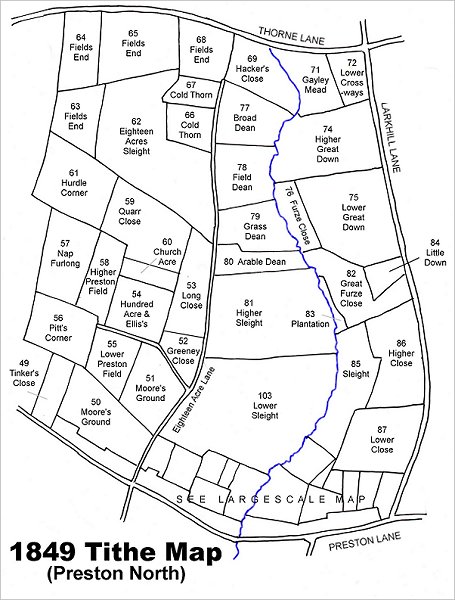
The 1849 Tithe Map of Preston Plucknett (north), showing the location of Higher Sleight (Parcel 81), the premises of the Flax Works, at centre.
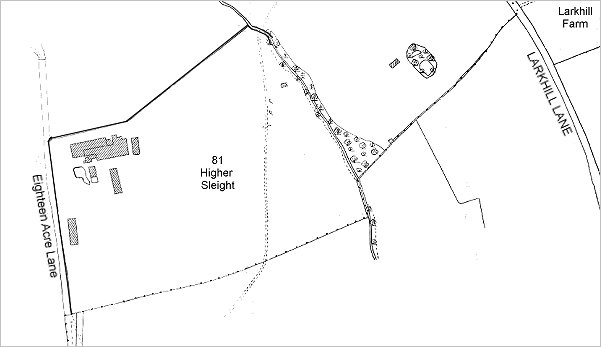
This map, based on the 1903 Ordnance Survey map, shows the Preston Plucknett Flax Works at left in relationship to Eighteen Acre Lane (which is now just a footpath) and Larkhill Lane (today's Larkhill Road).
GALLERY
The following five colourised photographs are courtesy of Alan Lawrie. His grandmother, Eunice Hillman (seated on the ground in the third photo below), lived in Weston Super Mare and was waiting to go to university in 1918. She was one of the 2,000 or more women taken from universities and colleges, and is almost certainly one of the 563 that were billeted in a tented camp at Barwick Park, since the photographs were taken by Witcomb & Son of Middle Street.

Photographed in 1918, the tented camp, believed to be at Barwick Park, accommodated 563 women flax workers.

Food preparation at the camp. It is likely that the two army personnel are soldiers from the Home Service Battalion of the Yorkshire Regiment who were billeted in the surrounding villages.

Young women flax workers pose in front of their tent. Unfortunately, the writing on the organisation badges the girls are wearing cannot be read.

Marching off to work in the flax fields.

A group of young women flax workers pose for a photograph by Witcomb & Son. Alan's grandmother, Eunice Hillman, is sitting on the ground at the front.
![]()
The following series of colourised photographs of young women working in the flax fields of Yeovil through to the processing of the flax, were taken by Horace Nicholls "on a farm in Yeovil" during the Great War of 1914-1918. These photographs are reproduced here under the terms of the Imperial War Museum's Non-Commercial License.
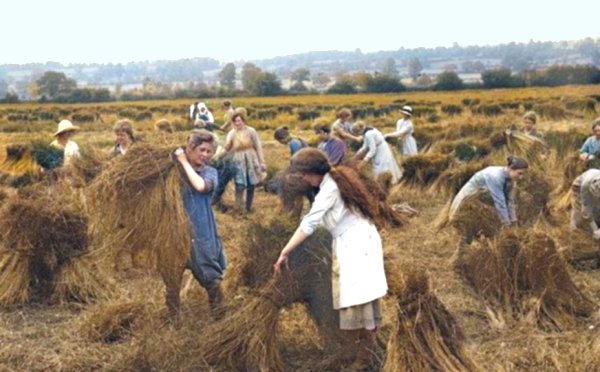
Colourised.
Reproduced under
the terms of the
Imperial War
Museum's
Non-Commercial
License.
Collecting flax from Yeovil fields in 1915. For the complete set of these images, click here.
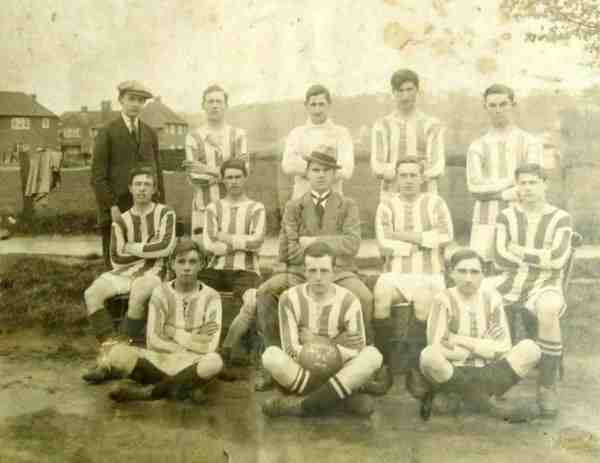
Courtesy of Sara
Sibley
The 1919-20 squad of Preston Flax Mills Football Club. The only known member is the white-jerseyed goalkeeper, Harry Sibley.
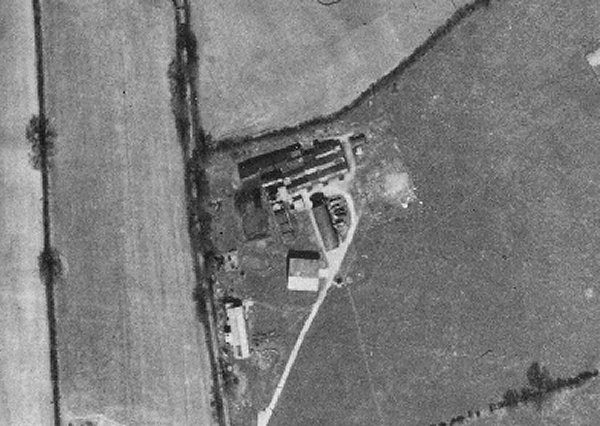
The Flax Works photographed in the 1946 aerial survey.
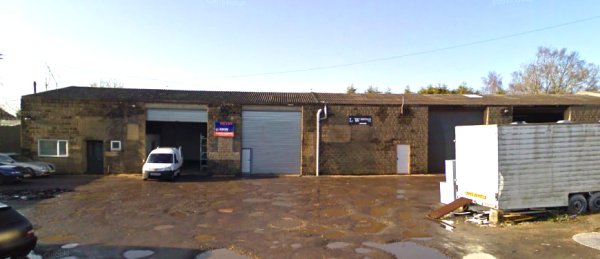
Some of the Flax Works buildings still survive as small industrial units on the Abbey Trading Estate.